Research on a Nonwoven Fabric Made from Multi-Block Biodegradable Copolymer Based on l-Lactide, Glycolide, and Trimethylene Carbonate with Shape Memory
Abstract
:1. Introduction
2. Results and Discussion
2.1. Thermal Characteristics of the Used Polymer and Fabricated Materials
2.2. Nonwoven Fabric Shrinkage and Thermal Stabilization Results
2.3. Physical and Structural Characteristics of Terpolymer Nonwoven Fabrics
2.4. Shape Memory Evaluation
3. Materials and Methods
3.1. Material Characterization
3.2. Polymer Processing
3.3. Test Methods
3.3.1. Thermal Analysis
3.3.2. Thermal Stabilization Process
3.3.3. Nonwoven Basic Structural Characterization
3.3.4. Scanning Electron Microscopic Examination
3.3.5. Porous Structure Assessment
3.3.6. Characterization of Shape Memory Behavior in DMTA Tensile Test
3.3.7. Thermo-Mechanical Shape Memory Experiment with Spiral Shaped Fabrics
4. Conclusions
Acknowledgments
Author Contributions
Conflicts of Interest
References
- Kariduraganavar, M.Y.; Doddamani, R.V.; Achari, D.D. Shape memory polymers in biomedical applications. In New Polymeric Composite Materials: Environmental, Biomedical, Actuator and Fuel Cell Applications; Inamuddin, Mohammad, A., Asiri, A.M., Eds.; Materials Research Forum: Millersville, PA, USA, 2016; pp. 1–60. [Google Scholar]
- Yahia, L.H. Shape Memory Polymers for Biomedical Applications; Woodhead Publishing: Cambridge, UK, 2015. [Google Scholar]
- Pilate, F.; Toncheva, A.; Dubois, P.; Raquez, J.M. Shape-memory polymers for multiple applications in the materials world. Eur. Polym. J. 2016, 80, 268–294. [Google Scholar] [CrossRef]
- Oliver, K.; Seddon, A.; Trask, R.S. Morphing in nature and beyond: A review of natural and synthetic shape-changing materials and mechanisms. J. Mater. Sci. 2016, 51, 10663–10689. [Google Scholar] [CrossRef]
- Liu, C.; Qin, H.; Mather, P.T. Review of progress in shape-memory polymers. J. Mater. Chem. 2007, 17, 1543–1558. [Google Scholar] [CrossRef]
- Hu, J. Shape Memory Polymers and Textiles; Woodhead Publishing: Cambridge, UK, 2007. [Google Scholar]
- Sokolowski, W.; Mercalfe, A.; Hayashi, S.; Yahia, L.; Raymond, J. Medical applications of shape memory polymers. Biomed. Mater. 2007, 2, 23–27. [Google Scholar] [CrossRef] [PubMed]
- Smola, A.; Dobrzyński, P.; Cristea, M.; Kasperczyk, J.; Sobota, M. Bioresorbable terpolymers based on l-lactide, glycolide and trimethylene carbonate with shape memory behaviour. Polym. Chem. 2014, 5, 2442–2452. [Google Scholar] [CrossRef]
- Dong, J.; Laio, L.; Tan, Z.; Fan, Z.; Li, S.; Lu, Z. A bioresorbable cardiovascular stent prepared from l-lactide, trimethylene carbonate and glycolide terpolymers. Polym. Eng. Sci. 2013, 54, 1418–1426. [Google Scholar] [CrossRef]
- Guerin, W.; Helou, M.; Carpentier, J.F.; Slawinski, M.; Brusson, J.M. Macromolecular engineering via ring-opening polymerization (1): l-Lactide/trimethylene carbonate block copolymers as thermoplastic elastomers. Polym. Chem. 2013, 4, 1095–1106. [Google Scholar] [CrossRef]
- Zini, E.; Scandola, M. Shape memory behavior of novel (l-lactide-glycolide-trimethylene carbonate) terpolymer. Biomacromolecules 2007, 8, 3661–3667. [Google Scholar] [CrossRef] [PubMed]
- Dobrzyński, P. Synthesis of biodegradable copolymers with low-toxicity zirconium compounds. Iii. Synthesis and chain-microstructure analysis of terpolymer obtained from l-lactide, glycolide, and epsilon-caprolactone initiated by zirconium(iv) acetylacetonate. J. Polym. Sci. Part A Polym. Chem. 2002, 40, 3129–3143. [Google Scholar] [CrossRef]
- Smola, A.; Dobrzyński, P.; Pastusiak, M.; Sobota, M.; Kasperczyk, J. New semi-crystalline bioresorbable materials with shape-memory properties. Eng. Biomater. 2009, 12, 82–87. [Google Scholar]
- Czajkowska, B.; Dobrzyński, P.; Bero, M. Interaction of cells with l-lactide/glycolide copolymers synthesized with the use of tin or zirconium compounds. J. Biomed. Mater. Res. Part A 2005, 74A, 591–597. [Google Scholar] [CrossRef] [PubMed]
- Czajkowska, B.; Bero, M.; Dobrzyński, P.; Kasperczyk, J. Research on biocompatibility of glycolide and lactide copolymers obtained with the use of new zirconium or tin initiators on the basis of in vitro experiments. Eng. Biomater. 2001, 17–19, 74–75. [Google Scholar]
- Dobrzyński, P.; Kasperczyk, J.; Bero, M.; Scandola, M.; Zini, E. Bioresorbable lactide/glycolide/trimethylene carbonate terpolymers with shape recovery properties. Eng. Biomater. 2007, 10, 45–47. [Google Scholar]
- Liu, Y.; Gall, K.; Dunn, M.L.; McCluskey, P. Thermomechanics of shape memory polymer nanocomposites. Mech. Mater. 2004, 36, 929–940. [Google Scholar] [CrossRef]
- Xu, J.W.; Song, J. Thermal responsive shape memory polymers for biomedical applications. Biomed. Eng. Front. Chall. 2011, 125–142. [Google Scholar] [CrossRef]
- Wu, X.; Huang, W.M.; Zhao, Y.; Ding, Z.; Tang, C.; Zhang, J. Mechanisms of the shape memory effect in polymeric materials. Polymers 2013, 5, 1169–1202. [Google Scholar] [CrossRef]
- Niu, Y.; Zhang, P.; Zhang, J.; Xiao, L.; Yang, K.; Wang, Y. Poly(p-dioxanone)-poly(ethylene glycol) network: Synthesis, characterization, and its shape memory effect. Polym. Chem. 2012, 3, 2508–2516. [Google Scholar] [CrossRef]
- Wong, Y.S.; Venkatraman, S.S. Recovery as a measure of oriented crystalline structure in poly(l-lactide) used as shape memory polymer. Acta Mater. 2010, 58, 49–58. [Google Scholar] [CrossRef]
- Athimoolam, M.; Moorthy, T.V. Polymer nanocomposites materials and shape memory applications—A review. Procedia Eng. 2012, 38, 3399–3408. [Google Scholar] [CrossRef]
- Xue, L.; Dai, S.; Li, Z. Biodegradable shape-memory block co-polymers for fast self-expandable stents. Biomaterials 2010, 31, 8132–8140. [Google Scholar] [CrossRef] [PubMed]
- Yang, C.S.; Wu, H.C.; Sun, J.S.; Wang, T.W. Thermo-induced shape-memory peg-pcl copolymer as a dual drug-eluting biodegradable stent. Appl. Mater. Interfaces 2013, 5, 10985–10994. [Google Scholar] [CrossRef] [PubMed]
- Dennis, C.; Sethu, S.; Nayak, S.; Mohan, L.; Morsi, Y. Suture materials-current and emerging trends. J. Biomed. Mater. Res. Part A 2016, 104, 1544–1559. [Google Scholar] [CrossRef] [PubMed]
- Lendlein, A.; Langer, R. Biodegradable, elastic shape-memory polymers for potential biomedical applications. Science 2002, 296, 1673–1676. [Google Scholar] [CrossRef] [PubMed]
- Cui, J.; Kratz, K.; Heuchel, M.; Hiebl, B.; Lendlein, A. Mechanically active scaffold from radio-opaque shape memory polymer-based composites. Polym. Adv. Technol. 2010, 22, 180–189. [Google Scholar] [CrossRef]
- Neuss, S.; Blomenkamp, I.; Stainforth, R.; Boltersdorf, D.; Jansen, M. The use of a shape-memory poly(ε-caprolactone)dimethacrylate network as a tissue engineering scaffold. Biomaterials 2009, 30, 1697–1705. [Google Scholar] [CrossRef] [PubMed]
- Wache, H.M.; Tartakowaska, D.J.; Hentrich, A.; Wagner, M.H. Development of a polymer stent with shape memory effect as a drug delivery system. J. Mater. Sci. Mater. Med. 2003, 14, 109–112. [Google Scholar] [CrossRef] [PubMed]
- Jelonek, K.; Kasperczyk, J. Polyesters and polyestercarbonates for controlled drug delivery. Polimery 2013, 58, 654–662. [Google Scholar] [CrossRef]
- Musiał-Kulik, M.; Kasperczyk, J.; Smola, A.; Dobrzyński, P. Double layer paclitaxel delivery systems based on bioresorbable terpolymer with shape memory properties. Int. J. Pharm. 2014, 465, 291–298. [Google Scholar] [CrossRef] [PubMed]
- Jelonek, K.; Kasperczyk, J.; Li, S.; Dobrzyński, P.; Jarzabek, B. Controlled poly(l-lactide-co-trimethylene carbonate) delivery system of cyclosporine a and rapamycine—The effect of copolymer chain microstructure on drug release rate. Int. J. Pharm. 2011, 414, 203–209. [Google Scholar] [CrossRef] [PubMed]
- Song, J.J.; Chang, H.H.; Naguib, H.E. Design and characterization of biocompatible shape memory polymer (smp) blend foams with a dynamic porous structure. Polumer 2015, 56, 82–92. [Google Scholar] [CrossRef]
- Metcalfe, A.; Desfaits, A.C.; Salazkin, I.; Yahia, L.; Sokolowski, W.; Raymond, J. Cold hibernated elastic memory foams for endovascular interventions. Biomaterials 2003, 24, 491–497. [Google Scholar] [CrossRef]
- Scislowska-Czarnecka, A.; Pamula, E.; Kolaczkowska, E. Biocompatibility evaluation of glycolide-containing polyesters in contact with osteoblasts and fibroblasts. J. Polym. Sci. 2012, 127, 3256–3268. [Google Scholar] [CrossRef]
- Dong, J.; Laio, L.; Ma, Y.; Shi, L.; Wang, G. Enzyme-catalyzed degradation behavior of l-lactide/trimethylene carbonate/glycolide terpolymers and their composites with poly(l-lactide-co-glycolide) fibers. Polym. Degrad. Stab. 2014, 103, 26–34. [Google Scholar] [CrossRef]
- Jaros, A.; Gębarowska, K.; Stojko, J.; Kasperczyk, J.; Smola, A. The mechanism of shape memory terpolymers in vivo degradation. Eng. Biomater. 2011, 14, 79–84. [Google Scholar]
- Kłosek, R.; Komacki, J.; Jelonek, K.; A, O.; Dobrzyński, P.; Kasperczyk, J. Biodegradable shape memory polymers-in vitro studies on human chondrocytes. Eng. Biomater. 2010, 13, 121–125. [Google Scholar]
- Orlik, B.; Buszman, P.P.; Krauze, A.; Gąsior, P.; Desperak, P.; Jacet, P. A nuclear magnetic resonance spectroscopy as a method for evaluation of in vivo poly-l-lactide biodegradation kinetics from stent-polymer matrices: An experimental study utilizing porcine model of in-stent restenosis. J. Cardiovasc. Pharmacol. Ther. 2016, 21, 93–99. [Google Scholar] [CrossRef] [PubMed]
- Turek, A.; Olakowska, E.; Borecka, A.; Janeczek, H.; Sobota, M.; Jaworska, J. Shape-memory terpolymer rods with 17-β-estradiol for the treatment of neurodegenerative diseases: An in vitro and in vivo study. Pharm. Res. 2016, 33, 2967–2978. [Google Scholar] [CrossRef] [PubMed]
- Rom, M.; Fabia, J.; Slusarczyk, C.; Janicki, J.; Kasperczyk, J. Structural transformation of terpolymer poly(l-lactide-glycolide-trimethylene carbonate) with shape memory effect during the degradation process. Polimery 2014, 59, 563–568. [Google Scholar] [CrossRef]
- Fabia, J.; Janicki, J.; Graczyk, T.; Dobrzyński, P.; Kasperczyk, M. Dsc, waxd and sem studies of biodegradation of poly(l-lactide-glycolide-trimethylene carbonate) shape memory terpolymer. J. Therm. Anal. Calorim. 2013, 113, 413–417. [Google Scholar] [CrossRef]
- Scislowska-Czarnecka, A.; Pamula, E.; Tlalka, A.; Kolaczkowska, E. Effects of aliphatic polyesters on activation of the immune system: Studies on macrophages. J. Biomater. Sci. 2012, 23, 715–738. [Google Scholar] [CrossRef] [PubMed]
- Gębarowska, K.; Kasperczyk, J.; Dobrzyński, P.; Scandola, M.; Elisa, Z. Nmr analysis of the chain microstructure of biodegradable terpolymers with shape memory properties. Eur. Polym. J. 2011, 6, 1315–1327. [Google Scholar] [CrossRef]
- Hu, J.; Meng, H.; Li, G.; Ibekwe, S.I. A review of stimuli-responsive polymers for smart textile applications. Smart Mater. Struct. 2012, 21, 1–23. [Google Scholar] [CrossRef]
- Tao, X. Smart Fibers, Fabrics and Clothing; Woodhead Publishing: Cambridge, UK, 2001. [Google Scholar]
- Michalak, M.; Krucińska, I. A smart fabric with increased insulating properties. Text. Res. J. 2015, 86, 97–111. [Google Scholar] [CrossRef]
- Nierstrasz, V.A. Textile-based drug release systems. In Smart Textiles for Medicine and Healthcare; Van Langenhove, L., Ed.; Woodhead Publishing: Cambridge, UK, 2007; pp. 50–74. [Google Scholar]
- Hu, J.; Chung, S.; Li, Y. Characterization about the shape memory behaviour of woven fabrics. Trans. Inst. Meas. Control 2007, 29, 301–319. [Google Scholar] [CrossRef]
- Zhou, H.; Hu, J.; Chen, S. Electrospun polyurethane nanofibres having shape memory effect. Mater. Lett. 2008, 62, 2074–2076. [Google Scholar] [CrossRef]
- Cha, D.; Kim, H.Y.; Lee, K.H.; Jung, Y.C.; Cho, J.W.; Chun, B.C. Electrospun nonwovens of shape-memory polyurethane block copolymers. J. Appl. Polym. Sci. 2005, 96, 460–465. [Google Scholar] [CrossRef]
- Bao, M.; Lou, X.; Zhou, Q.; Dong, W.; Yuan, H.; Zhang, Y. Electrospun biomimetic fibrous scaffold from shape memory polymer of pdlla-co-TMC for bone tissue engineering. Appl. Mater. Interfaces 2014, 6, 2611–2621. [Google Scholar] [CrossRef] [PubMed]
- Mathew, A.P.; Cho, K.H.; Uthaman, S.; Cho, C.S.; Park, I.K. Stimuli-regulated smart polymeric systems for gene therapy. Polymers 2017, 9, 152. [Google Scholar] [CrossRef]
- Yakacki, C.M.; Shandas, R.; Lanning, C.; Rech, B.; Eckstein, A.; Gall, K. Unconstrained recovery characterization of shape-memory polymer networks for cardiovascular applications. Biomaterials 2007, 28, 2255–2263. [Google Scholar] [CrossRef] [PubMed]
- Puchalski, M.; Sulak, K.; Chrzanowski, M.; Sztajnowski, S.; Krucinska, I. Effect of processing variables on the thermal and physical properties of poly(l-lactide) spun bond fabrics. Text. Res. J. 2015, 85, 535–547. [Google Scholar] [CrossRef]
- Walczak, J.; Sobota, M.; Chrzanowski, M.; Krucińska, I. Application of the melt-blown technique in the production of shape-memory nonwoven fabrics from a blend of poly(l-lactide) and atactic poly[(r,s)-3-hydroxy butyrate]. Text. Res. J. 2017. [Google Scholar] [CrossRef]
- Urbańczyk, G.W. Fizyka Włókna; Lodz University of Technology: Lodz, Poland, 2002; pp. 238–266. [Google Scholar]
Sample Availability: None of the compounds are available from the authors. |
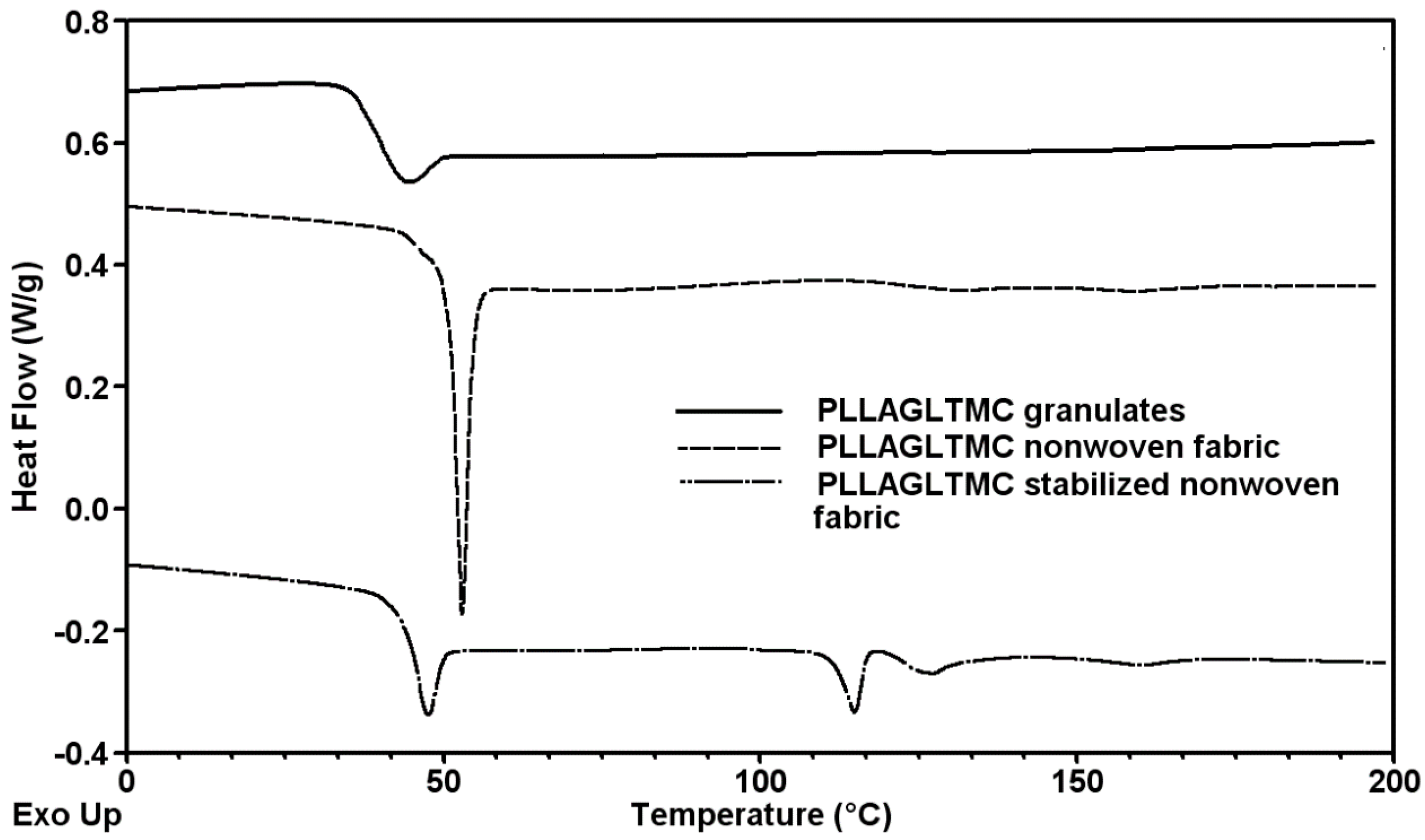
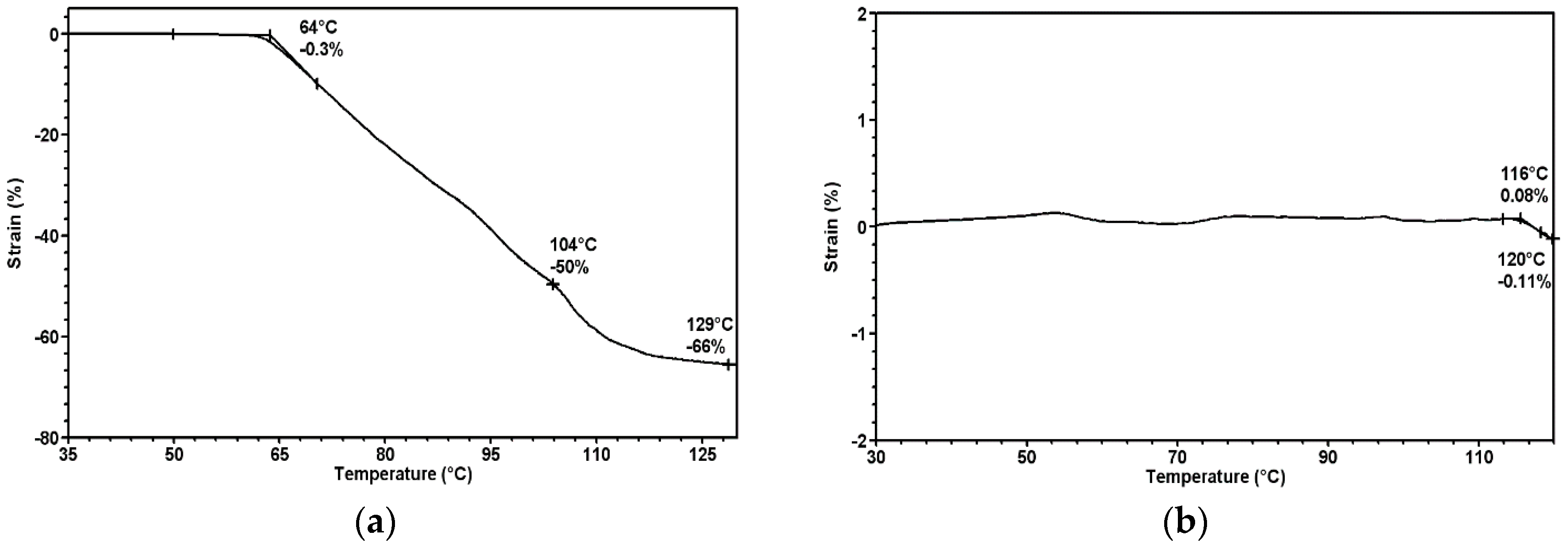
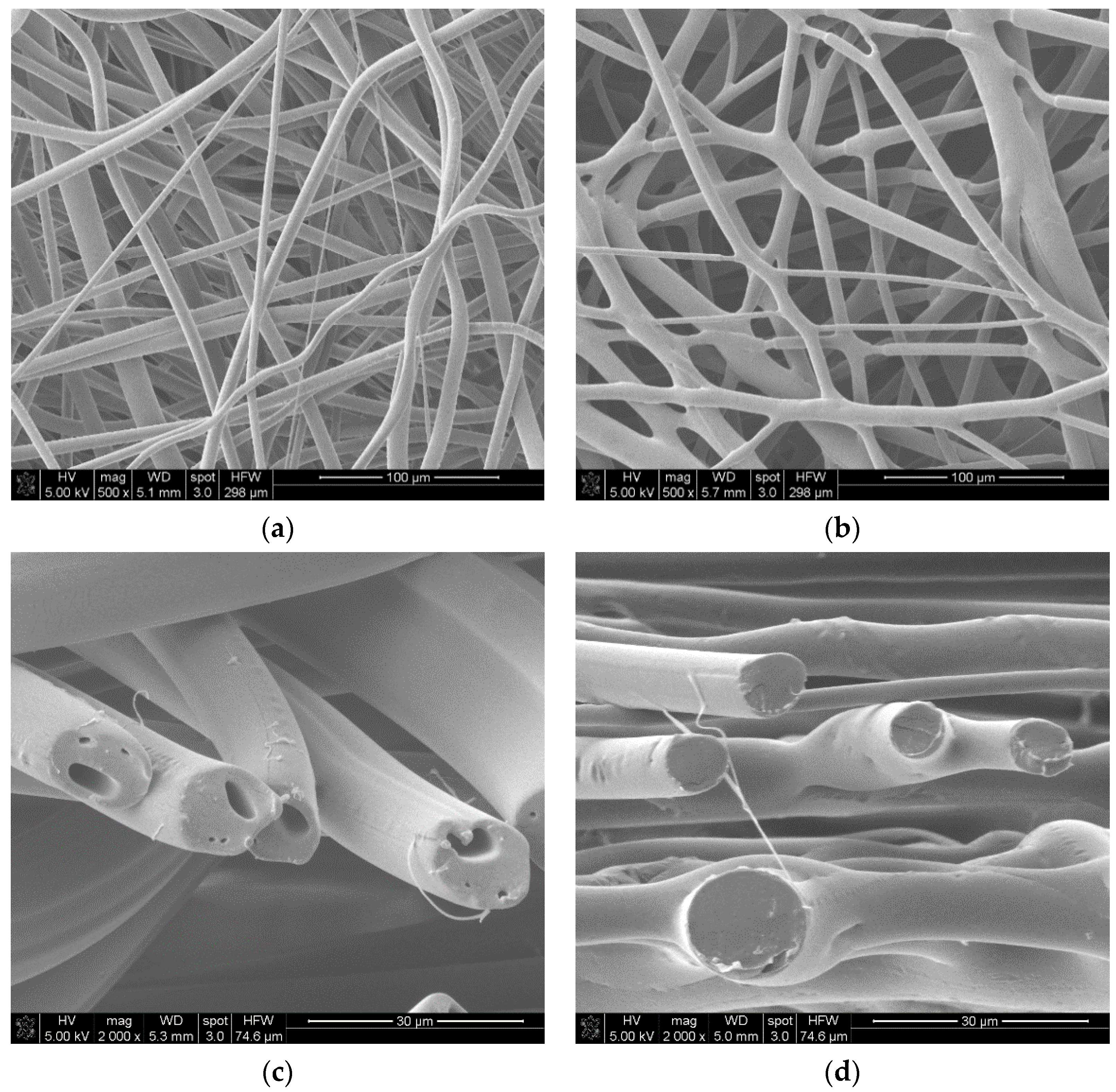

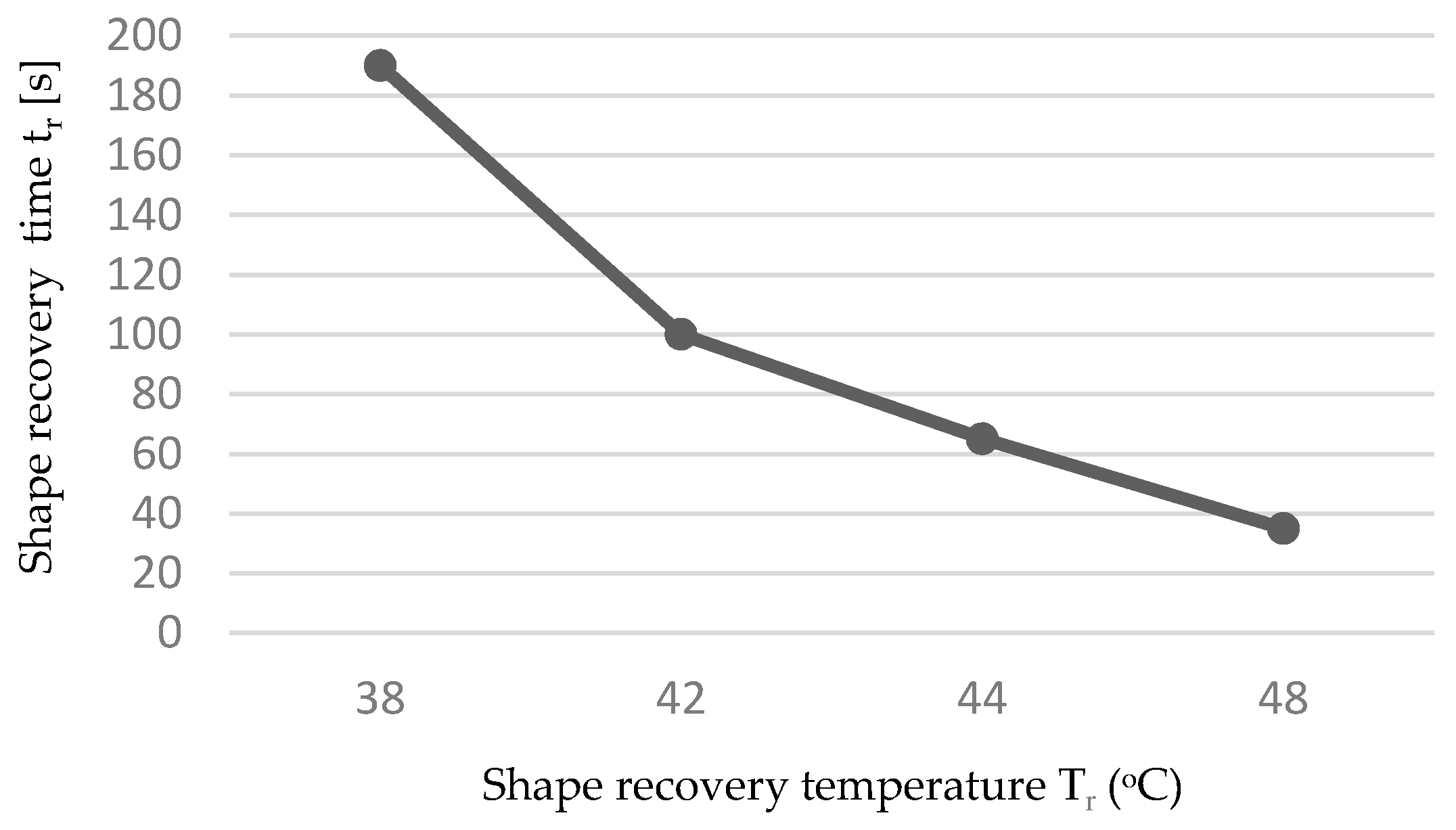
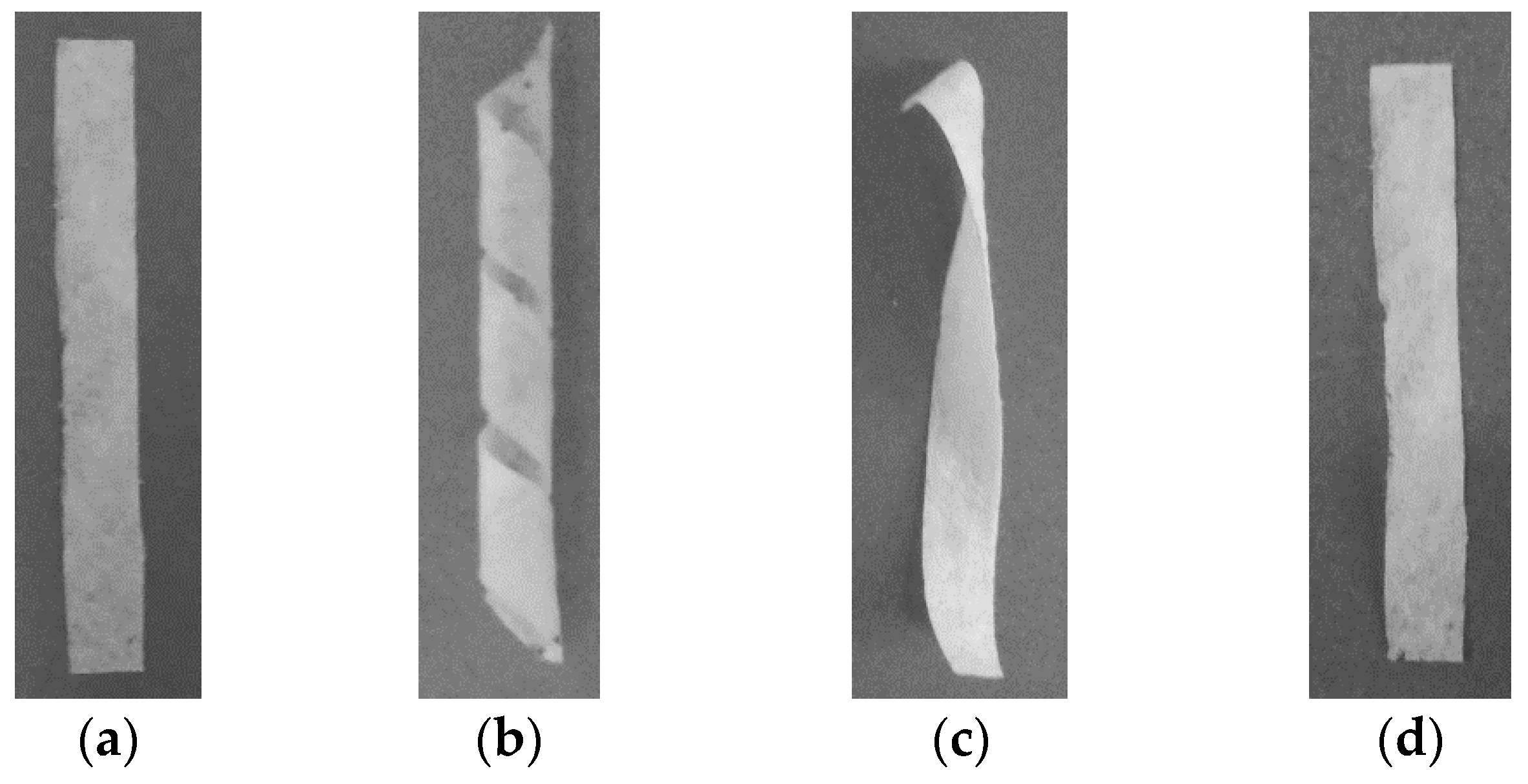
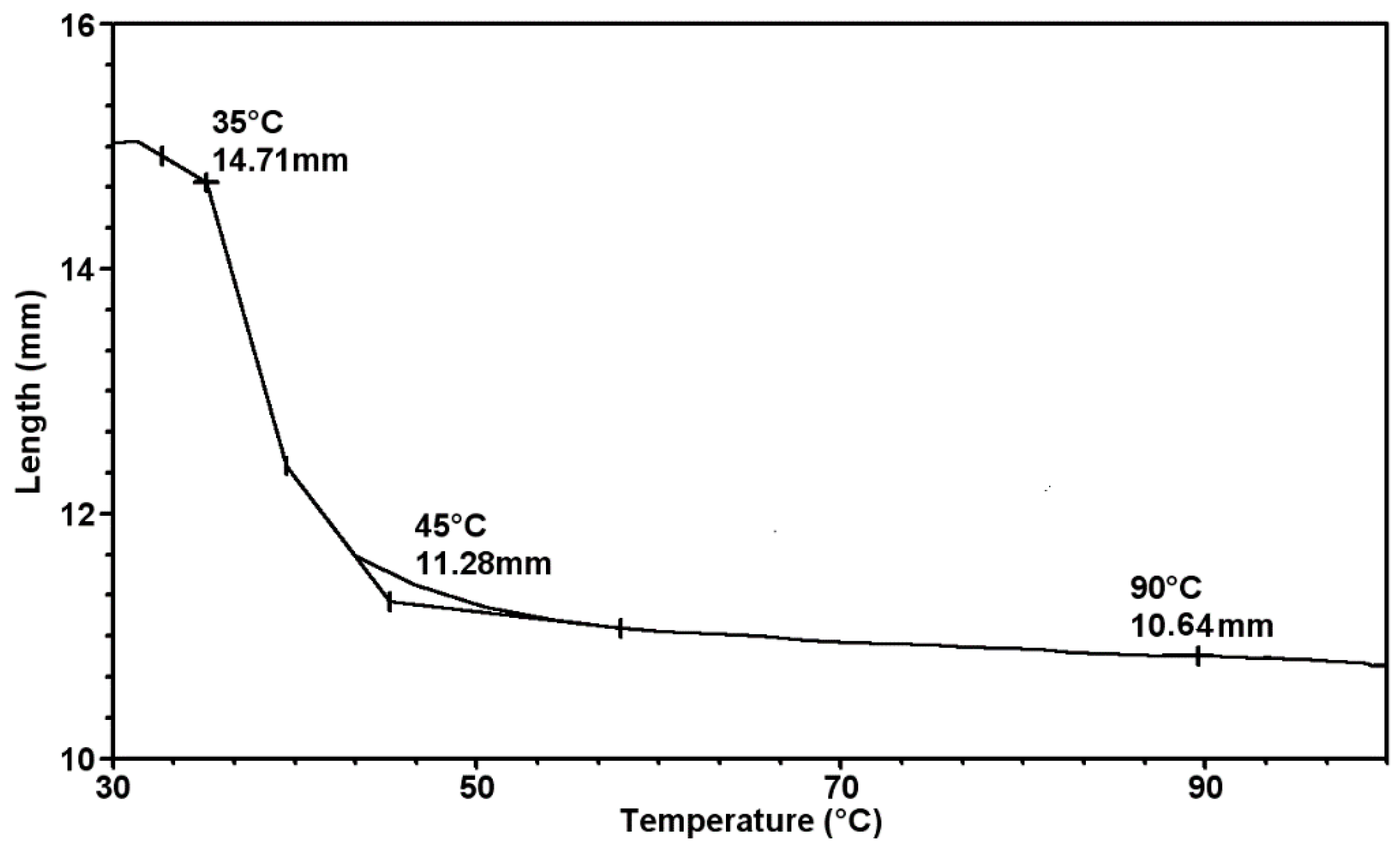

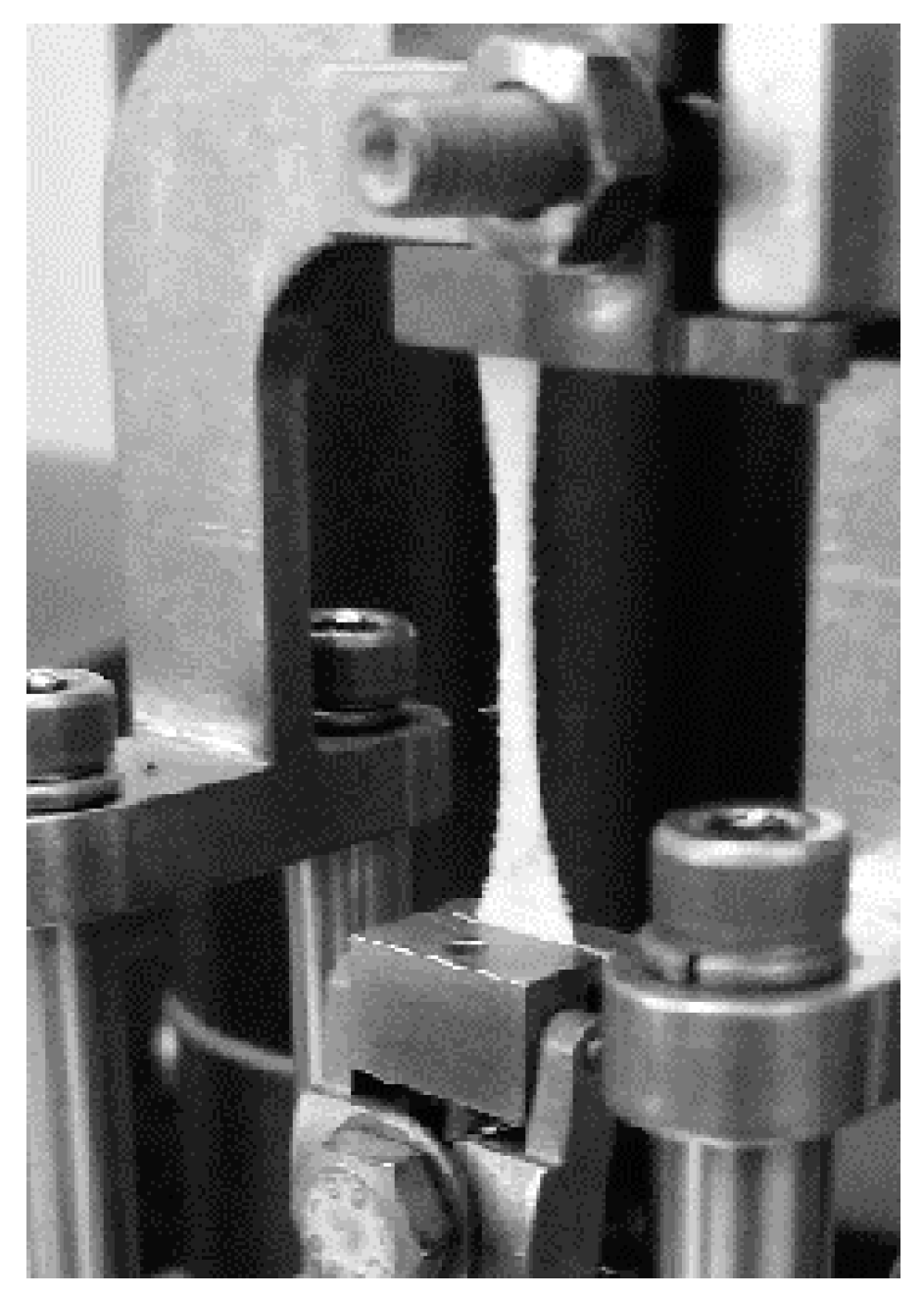
| Material | Heating Cycle | Glass Temperature Tg, (°C) | Melting Temperature Tm, (°C) | Enthalpy of Melting ΔHm, (J/g) |
|---|---|---|---|---|
| PLLAGLTMC granulates | 1st | Onset: 35.4 Midpoint: 37.7 | - | - |
| 2nd | Onset: 40.2 Midpoint: 42.3 | - | - | |
| PLLAGLTMC nonwoven fabric | 1st | Onset: 38.0 Midpoint: 47.4 | 131.0 159.3 | 0.5 0.5 |
| PLLAGLTMC nonwoven fabric after thermal stabilization | 1st | Onset: 42.3 Midpoint: 43.3 | 114.8 127.0 160.0 | 2.3 1.2 0.6 |
| Material | Thickness of Fabrics (mm) (cv, %) | Mass per Unit Area (g/m2) (cv, %) | Average Fiber Diameter (µm) (cv, %) | Apparent Density (kg/m3) | Total Pore Area (m2/g) | Average Pore Diameter (nm) |
|---|---|---|---|---|---|---|
| PLLAGLTMC nonwoven fabric | 0.63(9.5) | 46.4(13.0) | 6.7(34.7) | 74.2 ± 0.1 | 19,233.7 ± 0.1 | 8.1 ± 0.1 |
| PLLAGLTMC nonwoven fabric after thermal stabilization | 0.48(10.0) | 56.2(16.7) | 6.9(46.2) | 116.6 ± 0.1 | 71.8 ± 0.1 | 3594.7 ± 0.1 |
| Temporary Shape | Shape Recovery Condition | Shape Recovery Temperature Tr (°C) | Shape Recovery Time tr (s) | Shape Recovery Ratio RT (%) | Shape Recovery Evaluation |
|---|---|---|---|---|---|
| Spiral | Immersion in water | 38 | 75 | - | Close to full recovery (Figure 6c) |
| Spiral | Immersion in water | 38 | 190 | - | Full recovery (Figure 6d) |
| Spiral | Immersion in water | 42 | 100 | - | Full recovery |
| Spiral | Immersion in water | 44 | 65 | - | Full recovery |
| Spiral | Immersion in water | 48 | 35 | - | Full recovery |
| 50% stretched | Immersion in water | 48 | 35 | 72 | - |
| 100% stretched | Immersion in water | 48 | 35 | 91 | - |
| 100% stretched | Heating in DMA | 35–90 | 8 36 | 78 85 | - |
| Air Stream Temperature (°C) | Die Temperature (°C) | Extruder Temperature (°C) | Air Flow Rate (m3/h) | Twin-Screw Extruder Rotation Velocity (rpm) | Die Collector Distance (cm) |
|---|---|---|---|---|---|
| 250 | 240 | 150 | 6 | 70 | 15 |
© 2017 by the authors. Licensee MDPI, Basel, Switzerland. This article is an open access article distributed under the terms and conditions of the Creative Commons Attribution (CC BY) license (http://creativecommons.org/licenses/by/4.0/).
Share and Cite
Walczak, J.; Chrzanowski, M.; Krucińska, I. Research on a Nonwoven Fabric Made from Multi-Block Biodegradable Copolymer Based on l-Lactide, Glycolide, and Trimethylene Carbonate with Shape Memory. Molecules 2017, 22, 1325. https://doi.org/10.3390/molecules22081325
Walczak J, Chrzanowski M, Krucińska I. Research on a Nonwoven Fabric Made from Multi-Block Biodegradable Copolymer Based on l-Lactide, Glycolide, and Trimethylene Carbonate with Shape Memory. Molecules. 2017; 22(8):1325. https://doi.org/10.3390/molecules22081325
Chicago/Turabian StyleWalczak, Joanna, Michał Chrzanowski, and Izabella Krucińska. 2017. "Research on a Nonwoven Fabric Made from Multi-Block Biodegradable Copolymer Based on l-Lactide, Glycolide, and Trimethylene Carbonate with Shape Memory" Molecules 22, no. 8: 1325. https://doi.org/10.3390/molecules22081325




